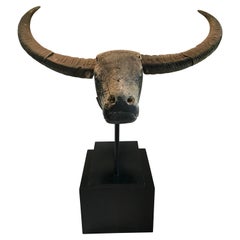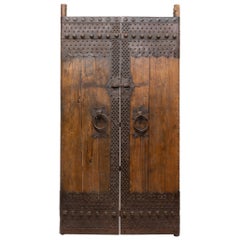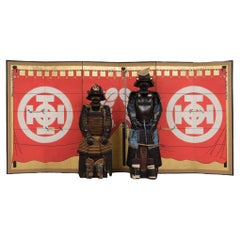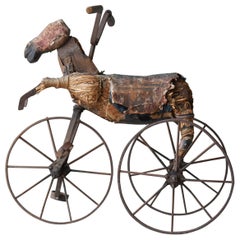Iron Antiquities
41
to
6
21
7
41
41
41
1
1
9
20
12
7
3
3
1
28,890
582
526
427
273
36
30
19
10
3
Material: Iron
Large 19th Century Indonesian Sculpture of a Bull
Located in Stockton, NJ
Massive and rare early 19th century Indonesian ship bowsprit. Originally a decoration on the front of a ship. Carved wood bull with natural horns. Museum mou...
Category
Early 19th Century Asian Antique Iron Antiquities
Materials
Iron
Samurai Helmet "Zunari Kabuto" - Early Edo (circa 1610)
Located in Paris, FR
Samurai Helmet "Zunari kabuto" with 3 black lacquered iron plates.
Japan, early EDO period, circa 1610.
Neck protector (shikoro), 5-strip hineno, laced brown, beige and green.
Centra...
Category
Early 17th Century Japanese Edo Antique Iron Antiquities
Materials
Iron
Pair of Chinese Iron Bound Courtyard Doors, c. 1850
Located in Chicago, IL
This impressive set of doors dates to the mid-19th century and originated as the outermost entrance gate to a traditional Qing dynasty courtyard home. Crafted of Northern elmwood (yu...
Category
Mid-19th Century Chinese Qing Antique Iron Antiquities
Materials
Iron
Japanese Antique Iron Block 1920s-1940s / Object Wabisabi
Located in Sammu-shi, Chiba
It is a very old iron block.
It is from the early Showa period (1920s-1940s).
Weight: approx. 50 kg.
It was used as a tool for steel workers.
They buried it in the ground and pound...
Category
Early 20th Century Japanese Showa Iron Antiquities
Materials
Iron
Rare set of 2 Japanese suits-of-armour, complete with 2 matching folding screens
Located in Amsterdam, NL
Important unique set of two suits-of-armour (yoroi), complete with two high six-panel screens, that belong together as is indicated by the used family crests (mon). Two crests are used, both belonging to the Nakagawa family of Oka Castle, Ôita prefecture on Kyûshû.
They are:
– the Nakagawa-kurusu, a circle depicting a Celtic-like cross through a ring.
The cross was originally a Christian symbol but after the ban on Christianity in Japan the use of a hidden cross in family crests could continue.
– the Nakagawa-kashiwa, two leaves of the Japanese Emperor Oak turned to each other (dakikashiwa mon).
The remarkable aspect of this ensemble is the presence of matching crests on both the yoroi and the accompanying folding screens. The kurusu and kashiwa crests adorning the yoroi are elegantly replicated on the screens, providing compelling evidence that these pieces form a harmonious and unified set. This exceptional cohesion between the armour and screens further enhances their artistic and historical value.
After the warlord Toyotomi Hideyoshi (1537-1598) had interfered in the battle between the Lord of Bungo Province Ôtomo Yoshi-mune (1558-1605) and the Shimazu of Hyûga Province, he split the Bungo Province in a number of small fiefs and transferred in 1594 Nakagawa Hideshige (1570-1612) from Miki Castle
in the Harima Fief to Oka Castle in Kyûshû.
The Nakagawa family stayed in possession of Oka Castle till the abolishment of the military use of castles in 1873. In 1884 the Nakagawa family received the title of Count (a title in use till the abolishment of aristocracy in 1947).
After the Nakagawa’s left, the castle and the building soon dilapidated and is now known as Oka Castle Ruins. The castle is located in Taketa Village part of Taketa Town in Ôita Province on Kyûshû.
> Set of two tall byôbu (folding screens),
painted with large red jinmaku (camp enclosure curtain) on a gold leaf ground. The curtains show both crests of the Nakagawa family: one screen depicts two Nakagawa-kurusu crests next to a Nakagawa-kashi crest in the middle, and the other shows the symbols the other way round.
Dimensions:
Total width 148.66 in/377.6 cm (2 x 25.35 in/64.4 cm, 4 x 24.48 in/62.2 cm); Height 72.63 in/184.5 cm.
Period: Japan – Late Edo period (First half 19th century), and maybe even older.
> Yoroi with Nakagawa-kashiwa crest:
A Japanese black lacquered suit-of-armour (yoroi) completely laced with orange cords (kuro’urushinuri hi’ito odoshi nimai’dô’maru).
A thirty-two plate suji’bachi kabuto (helmet with raised ridges) with in front a maedate (fore crest) -with traces of gilding- in the shape of flames, resembling a mythical flaming bird flying down. The fukikaeshi (face guards) and the mabizashi (visor) have the Nakagawa-kashiwa crest in gold maki-e lacquer.
Five curved ‘itazane’-plate neck guards (shikoro) laced with orange cords.
Together with an ‘angry man...
Category
18th Century Japanese Antique Iron Antiquities
Materials
Gold Leaf, Iron, Metal
Japanese Antique Wooden Horse Tricycle 1860s-1900s / Sculpture Wabisabi
Located in Sammu-shi, Chiba
Very old tricycle with wooden horse made in Japan.
It is from the Meiji period (1860s-1900s).
It is made of iron, cedar wood, straw, and paper.
In Japan at that time, only a few wea...
Category
Early 20th Century Japanese Meiji Iron Antiquities
Materials
Iron
Pair of Japanese cast iron chôshi 銚子 (sake kettles) with lacquered lids
Located in Amsterdam, NL
Pair of enticing cast iron chôshi (sake kettles) with a detailed lacquered lid, raised by three low feet. Its rotund body with a subtle embossed design of stylized symbols, like myth...
Category
Early 19th Century Japanese Antique Iron Antiquities
Materials
Silver, Iron
18th Century, Japanese Edo Period Lacquer & Chain Mail Suit of Samurai Armor
Located in Atlanta, GA
Japanese, Edo Period (1603-1868), likely late 18th century.
Step into the rich tapestry of Japanese history with this exquisite 18th-century Edo Period Lacquer & Chain Mail Suit of Armor, a masterpiece that seamlessly blends martial craftsmanship with artistic elegance. Crafted during a period of unparalleled cultural refinement, this armor is a testament to the meticulous skill and dedication of Japanese artisans.
The Gosuko armor, at the heart of this ensemble, embodies the traditional armor design of the Edo Period. Each meticulously lacquered plate, carefully adorned with ornate motifs, reflects not only the functional sophistication required for battle but also the aesthetic sensibilities intrinsic to Japanese art. The incorporation of chain mail adds a layer of flexibility and mobility, harmonizing the demands of protection with the fluidity required in combat.
A crowning glory to this armor is the Kabuto Helmet, an iconic symbol of samurai identity and resilience. Its design not only provides formidable protection but also serves as a canvas for artistic expression. The helmet's form, combined with lacquer embellishments and a crest, creates a striking visual statement, a representation of the wearer's identity and lineage.
To complete the ensemble, the armor comes with a brocade fabric, adding a touch of regality to this already magnificent piece. The interplay of textures and colors in the brocade further elevates the visual impact, turning the act of donning this armor into a ceremonial experience.
For the discerning collector, this piece is presented in a lacquer armor box, meticulously crafted to safeguard and showcase the historical significance of the armor. The accompanying wood armor display stand serves as a stage, allowing this masterpiece to command attention in any setting, whether it be a private collection, museum exhibit, or a distinguished living space.
Owning this 18th-century Japanese Edo Period Lacquer...
Category
18th Century Japanese Japonisme Antique Iron Antiquities
Materials
Iron, Gold Leaf
19th Century, Meiji, Antique Japanese Iron Teapot with Bronze Lid
Located in Sampantawong, TH
Antique Japanese iron teapot with bronze lid.
Age: Japan, Meiji Period, 19th Century
Size: Height 19.8 C.M. / Width 17.3 C.M. / Diameter 15.5
Co...
Category
19th Century Japanese Antique Iron Antiquities
Materials
Bronze, Iron
18th Century Hirate Clan Samurai Armor with Signed Kabuto Helmet
Located in Fukuoka, JP
This is a truly exceptional set of 18th century Samurai armor that is sure to impress any collector or enthusiast. The patinated iron used in its construction has aged beautifully, giving the armor a truly unique appearance that is sure to catch the eye. The brocade silk and cotton padding used to line the armor not only provide a comfortable fit for the wearer, but also add an extra layer of decorative flair.
One of the most striking features of this armor is the crests of the Hirate samurai clan that adorn it. These crests are a symbol of the clan's identity and heritage, and their presence on the armor speaks to the deep connection between samurai warriors and the clans they belonged to.
The Kabuto...
Category
18th Century Japanese Antique Iron Antiquities
Materials
Iron
Signed Japanese Edo suji’bachi kabuto (helmet) with a moon & cloud maedate
Located in Amsterdam, NL
An antique, outstanding signed suji’bachi kabuto (helmet with ridges) surmounted by a gilt metal maedate (forecrest) shaped like a full moon emerging from the clouds heightened by a ...
Category
Early 19th Century Japanese Antique Iron Antiquities
Materials
Metal, Iron
20th Century Temple Altar Door Gilded Applique, Set
Located in Fukuoka, JP
Set of Large Buddhist temple Altar door decorative applique. Gilded copper, depicting flying Phoenix. Can be easily used to adorn any door. Solid copper...
Category
20th Century Japanese Iron Antiquities
Materials
Iron
Antique Cast Iron Hay Grapple Farm Barn Hook Metal Forks Country Decor
Located in Philadelphia, PA
Antique Cast Iron Hay Grapple Farm Barn Hook Metal Forks Country Decor. Circa Early 1900s. Measurements: 37" H x 41" W x 18" D. 55" at widest point when open.
Category
Early 1900s Country Antique Iron Antiquities
Materials
Iron
Antique Small Chest of Drawers from 19th Century, Japan
Located in Edogawa-ku Tokyo, JP
Antique small chest of drawers from Edo period (1603-1868), Japan.
Because of its age, the chest shows signs of use, which in turn make...
Category
19th Century Japanese Antique Iron Antiquities
Materials
Iron
Sponge Ware Pottery "Butter" Crock, 19th Century
Located in Los Angeles, CA
19th century Large sponge ware crock with minor hairline crack. Sold as is.
Category
Mid-19th Century American American Classical Antique Iron Antiquities
Materials
Iron
Cast Iron Indian Game with Rider and Horses
Located in Milano, IT
Welded cast iron toy from the Indian 900s depicting a chariot with a square canopy and conical dome. We can identify this toy-statue as a depiction of Krishna’s Rath Gita (Bhagavad Gita...
Category
Early 1900s Indian Anglo-Indian Antique Iron Antiquities
Materials
Iron
China 100 BC Han Dynasty Ancient Rare Stickman Sculpture in Earthenware Pottery
Located in Miami, FL
Standing Stickman from the Han Dynasty.
Original ancient Chinese tomb attendants sculpture of a tall, thin standing man wearing a short tunic. Beautifully crafted in grey earthenw...
Category
15th Century and Earlier Chinese Han Antique Iron Antiquities
Materials
Iron
Painted Chinese Rice Measure, c. 1900
Located in Chicago, IL
This rustic container was made over a hundred years ago to measure and hold a dou of rice, an ancient Chinese measurement. The wooden vessel has a sq...
Category
Early 1900s Chinese Qing Antique Iron Antiquities
Materials
Iron
Japanese Antique Tricycle 1900s-1940s / Three Wheeler Figurine Wabi Sabi Object
Located in Sammu-shi, Chiba
This is a very old Japanese tricycle.
This item is from the early Showa period (1900s-1940s).
The handle is made of wood and the seat is made of leather.
Everything else is made of i...
Category
Mid-20th Century Japanese Showa Iron Antiquities
Materials
Steel, Iron
Pair of Chinese Iron Bound Courtyard Doors, c. 1900
Located in Chicago, IL
This impressive set of doors dates to the turn of the century and originated as the outermost entrance gate to a traditional courtyard home in northern China. Crafted of locust wood and hand-worked iron, the rustic doors have developed a fantastic texture from years of use. The original layer of dark brown lacquer has eroded with an inimitable crackle, revealing the beautiful wood grain underneath.
The door fronts are reinforced with studded iron bands and decorative iron plates in the shape of clouds or ruyi. The doors are fitted with a simple iron latch and four round door pulls...
Category
Late 19th Century Chinese Qing Antique Iron Antiquities
Materials
Iron
Pair of Chinese Black Lacquer Courtyard Doors, C. 1850
Located in Chicago, IL
This impressive set of doors dates to the turn of the century and originated as the outermost entrance gate to a traditional courtyard home in northern China. The pair is crafted of northern elm (yumu) and finished with dark black lacquer and hand-worked iron hardware. Bands of studded iron reinforce the fronts and simple iron plates secure the door latch and round door pulls...
Category
Mid-19th Century Chinese Qing Antique Iron Antiquities
Materials
Iron
Antique Ironware, Incense Plate, Indonesia 18th Century
Located in Kyoto-shi, Kyoto
Old ironware from the 18th century.
It is an old ironware used in Balinese ceremonies. This item is in the shape of a water buffalo horn and is extremely rare.
There is no unnecessary decoration, there is a simple sophisticated atmosphere, it is an art piece.
As in the first photo, it is also recommended to enjoy it likened to an incense plate.
Category
18th Century Balinese Antique Iron Antiquities
Materials
Iron
Japanese Antique Combat Helmet 'Kabuto' 1800s Edo Era
Located in Paris, FR
This is an antique combat helmet made around 1800s in Edo era in Japan.
Kabuto is a type of helmet first used by ancient Japanese warriors which, in later periods, became an important part of the traditional Japanese armour...
Category
Early 19th Century Japanese Antique Iron Antiquities
Materials
Iron
Pair of Chinese Courtyard Doors with Iron Butterflies, c. 1850
Located in Chicago, IL
This imposing set of doors dates to the mid-19th century and once enclosed the inner courtyard of a Qing-dynasty home in northern China. The double doors are crafted of northern elm (yumu), a common hardwood appreciated for its strength, warm coloring and expressive grain.
The fronts are reinforced with iron bands studded with brass hobnails and decorated with hard-worked iron plates with a foliated design. A square lock plate secures two round door pulls and a simple door latch, engraved with an everlasting knot, lotus blossoms, and ornamental koi. Little iron butterflies flit across the front, auspicious symbols of blessings, happiness and longevity. The monumental doors...
Category
Mid-19th Century Chinese Qing Antique Iron Antiquities
Materials
Brass, Iron
Antique Small Chest of Drawers from Edo period 19th Century, Japan
Located in Edogawa-ku Tokyo, JP
Antique small chest of drawers from Edo period (1603-1868), Japan.
If you look closely at the top surface, you can see writing on it.
...
Category
19th Century Japanese Antique Iron Antiquities
Materials
Iron
Pair of Chinese Iron Bound Courtyard Doors with Frame, c. 1850
Located in Chicago, IL
This monumental pair of doors dates to the mid-19th century and once enclosed the inner courtyard of a grandQing-dynasty home in northern China. The courtyard doors are crafted of northern elm (yumu) and are complete with the original door frame comprised of thick wood beams. The door fronts are reinforced with studded iron bands and decorative iron plates with a foliate design. The doors close by a simple iron latch and open with two round door pulls...
Category
Mid-19th Century Chinese Qing Antique Iron Antiquities
Materials
Iron
Pair of Japanese High Quality Chôshi 銚子 'Sake Ewers', Signed 'Sei’ô' 晴王
Located in Amsterdam, NL
Pair of high quality cast iron chôshi (sake ewers) with a detailed lacquered lid. Its body with a refined embossed design of a bird of prey (môchô) perched o...
Category
Late 19th Century Japanese Antique Iron Antiquities
Materials
Iron
19th Century, Meiji, Antique Japanese Iron Teapot with Artist Sign
Located in Sampantawong, TH
Japanese iron teapot with artist sign.
Age: Japan, Meiji Period, 19th Century
Size: height 24.3 cm / width 16 cm
Condition: Nice condition ov...
Category
19th Century Japanese Antique Iron Antiquities
Materials
Iron
Antique Ceremonial Dress and Sword Tansu, Sendai, Japan
Located in Point Richmond, CA
Antique ceremonial dress and sword tansu, Sendai, Japan
Guaranteed to be authentic as described.
Category
Early 20th Century Japanese Iron Antiquities
Materials
Iron
Provincial Chinese Rice Measure, circa 1900
Located in Chicago, IL
This square container was made over a hundred years ago to measure and hold a dou of rice, an ancient Chinese measurement. It is handcrafted with thin finger joints, iron-finished edges, and a gently arched handle. Marked by painted Chinese characters on each side, this antique measure...
Category
Early 20th Century Chinese Qing Iron Antiquities
Materials
Iron
13/14thC Large Thickly Cast Iron Korean Buddha, 9020
Located in Ukiah, CA
Very rare large thickly cast iron Korean Buddha (a magnet sticks to it). In an extremely early backless style. I believe this piece could be as late as 1...
Category
15th Century and Earlier Korean Antique Iron Antiquities
Materials
Iron
Early Mon Style Solid Cast Iron Standing Buddha from Burma, 5613
Located in Ukiah, CA
This is a very rare early Mon style solid cast iron standing Buddha from Burma, probably the 10th century. He is one of a kind- I’ve seen related pieces, but never another quite like...
Category
15th Century and Earlier Asian Antique Iron Antiquities
Materials
Iron
19th Century Brass and Iron Lion Andirons
Located in San Diego, CA
Luxurious and regal pair of 19th century iron and brass lion andirons. Beautifully sculpted, the brass lions, a symbol of regal strength, rest a top the a...
Category
Late 19th Century European Regency Antique Iron Antiquities
Materials
Brass, Iron
Indian Antique Smelting Pot with Back Handle, Front Spout and Weathered Patina
Located in Yonkers, NY
An Indian antique smelting pot from the 19th century, with back handle, front spout and nice patina. Created in India during the 19th century, th...
Category
19th Century Indian Antique Iron Antiquities
Materials
Iron
Chinese Ware Sheep Head Cup
By Yang Qing He
Located in Brea, CA
A Chinese ware sheep head cup.
Category
20th Century Chinese Chinese Export Iron Antiquities
Materials
Iron
Late 18th-Early 19th Century Swing Post Mount Whale Oil Lamp
Located in Ottawa, Ontario
A late 18th-early 19th century swing post mount whale oil lamp, a fine example of a ships or wall/post mount whale oil lamp, which swings from the top a...
Category
19th Century British Colonial Antique Iron Antiquities
Materials
Iron
Large Cast Iron Tub with Floral Motif
Located in Greenwich, CT
Large cast iron tub with floral motif with four ring pulls, there is one casted inscription on one side with date made : " Emperor Qianglong Era 32nd yea...
Category
Late 19th Century Chinese Qing Antique Iron Antiquities
Materials
Iron
Asian Architectural Temple Stone Panel from India Made into a Coffee Table
Located in North Hollywood, CA
Carved stone outstanding Asian architectural stone panel relief from India made into a side or coffee table.
Antique hand carved stone temple architectural panel with hand carved pea...
Category
1950s Indian Agra Vintage Iron Antiquities
Materials
Iron
Japanese Antique Iron Plate 1920s-1940s / Abstract Art Wabi Sabi
Located in Sammu-shi, Chiba
It is a very old iron plate made in Japan.
This item is from the early Showa period (1920s-1940s).
This iron plate was a work plate for kneading mortar.
Due to the passage of time o...
Category
Mid-20th Century Japanese Showa Iron Antiquities
Materials
Iron
Antique Wrought Iron Metal Primitive Rustic Buggy Carriage Wheels, a Pair
Located in Philadelphia, PA
Antique Wrought Iron Metal 54" Primitive Rustic Buggy Carriage Wheels - a Pair. Great to convert to a dining table or other decorative projects. Item features heavy iron construction...
Category
19th Century Primitive Antique Iron Antiquities
Materials
Iron
17th-18th Century Edo Period Samurai Armor Sangu Parts, 'Haidate & Kote'
Located in Fukuoka, JP
Introducing a truly rare and remarkable item up for auction, we present the Rare Samurai Sangu armor parts, which include arms and thigh armor pieces. This extraordinary ensemble, marked with the unique identifier , originates from the mid Edo period, circa the 17th to 18th century.
While this set of armor has experienced the passage of time, it remains in fine condition, bearing witness to its historical significance. Please note that there are some rust issues present throughout, which only add to the authenticity and character of this exceptional piece. Additionally, the original silk fabric has largely deteriorated, as depicted in the accompanying photos.
Designed to fit a full adult size, this Samurai Sangu armor is a versatile addition to any historic samurai armor collection. The included arms and thigh armor pieces complete the ensemble, ensuring an immersive and comprehensive representation of traditional samurai warfare attire.
Weighing approximately 3 kilograms (6.6 pounds), this set strikes a balance between durability and mobility, allowing the wearer to move with ease while maintaining essential protection. It is essential to note that this item is sold in "as-is" condition, preserving its original state and historical integrity.
International buyers are responsible for any import duties, taxes, and charges associated with the purchase. It is recommended to consult with your country's customs office to determine the specific costs involved before placing a bid or making a purchase.
Own a rare piece of samurai history with this exceptional Rare Samurai Sangu armor set...
Category
Late 17th Century Japanese Edo Antique Iron Antiquities
Materials
Iron




